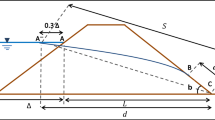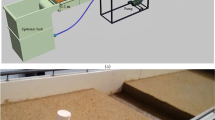Abstract
Levees are facilities constructed along river to protect floodplains against flooding. However, levee failures are also possible if seepage reaches landside surface of the levee. The seepage on the surface of the landside slope can be prevented by efficient design of levee drainage systems. This study aims to show the seepage control potential on levees by installation of perforated drainpipes, which was verified through hydraulic experiments. Scenarios were performed with four different water stages at riverside. For each scenario, the piezometric heads located at the bottom of the experimental levee were measured. The results of the hydraulic experiments showed that the precise positioning of perforated drainpipes is vital since it greatly affects the amount of seepage in the levee. The SEEP/W model that was calibrated and verified with the experiment results was used to suggest appropriate installation location range of the perforated drainpipe. From the numerical simulation, as the central location of perforated drainpipe is closer to landside levee toe horizontally and to foundation surface vertically, the safety of levee was increased from the seepage failure.
Similar content being viewed by others
References
Choi, J. J. (2007). Reasonable seepage measure of river levee, MSc Thesis, Kyungpook National University, Daegu, Korea.
Das, B. M. (2005). Principles of geotechnical engineering.
Desai, C. S. (1973). “Approximate solution for unconfined seepage.” Journal of the Irrigation and Drainage Division, Vol. 99, No. 1, pp. 71–87.
Geo-Slope International Ltd. (2009). Seepage modeling with SEEP/W 2007, Fourth Edition, Calgary, Alberta, Canada.
Gong, Y., Kang, T., and Lee, S. (2012). “A Study for seepage control of levee with a pervious toe drain.” Journal of Korea Water Resources Association, Korea Water Resources Association, Vol. 45, No. 6, pp. 569–581, DOI: 10.3741/JKWRA.2012.45.6.569.
Hopf, F. (2011). Levee failures in the Sacramento-San Joaquin River Delta: Characteristics and perspectives, PhD Thesis, Texas A&M University, Texas, USA.
Japan Institute of Construction Engineering (1998). Design guideline of drain in levee for seepage control.
Kang, T., Lee, S., and Lee, N. (2014). “A study on establishment of institutional system to increase safety of levees and drainage culverts.” Korean Review of Crisis & Emergency Management, Vol. 10, No. 3, pp. 119–134.
Kang, T., Ru, K., Lee, S., and Lee, N. (2013). “Seepage control method for levees by riprap drain in Japan.” Magazine of Korea Water Resources Association, Korea Water Resources Association, Vol. 46, No. 3, pp. 48–54.
Korea Institute of Construction & Transportation Technology Evaluation and Planning (2006). “A study for seepage control of levee.” Ministry of Construction Transportation, pp. 43-62.
Korea Water Resources Association (2009). River design criteria explanation.
Liu, C. and Yang, J. (2001). “United method for calculation of seepage control by adopting weighting soil layer on back side of dike.” Journal of Hydrodynamics Series B-English Edition, Vol. 13, No. 4, pp. 92–97.
Neuman, S. P. and Witherspoon, P. A. (1970). “Finite Element Method of analyzing steady seepage with a free surface.” Water Resources Research, Vol. 6, No. 3, pp. 889–897, DOI: 10.1029/WR006i003p00889.
Taylor, R. L. and Brown, C. B. (1967). “Darcy flow solutions with a free surface.” Journal of Hydraulic Division, ASCE, Vol. 93, No. 2, pp. 25–33.
U.S. Army Corps of Engineers (2000). Design and Construction of Levees, CECW-EG, EM1110-2-1913, Washington, D.C., pp. 5-9.
Yoon, K. S. (2004). “Analysis for failure types of levees and design method.” Magazine of Korea Water Resources Association, Korea Water Resources Association, Vol. 37, No. 5, pp. 50–60.
Author information
Authors and Affiliations
Corresponding author
Rights and permissions
About this article
Cite this article
Seo, H., Kang, T., Felix, M.L. et al. A study to determine the location of perforated drainpipe in a levee for controlling the seepage line. KSCE J Civ Eng 22, 153–160 (2018). https://doi.org/10.1007/s12205-017-1330-2
Received:
Accepted:
Published:
Issue Date:
DOI: https://doi.org/10.1007/s12205-017-1330-2




